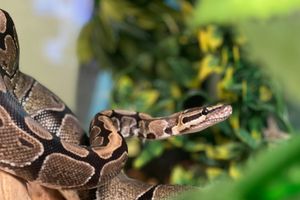
COMMON NAME: Ball Python, Royal Python
SCIENTIFIC NAME: Python regius
Ball pythons are modestly sized snakes that range from 30-45" in length and rarely reach five feet or slightly longer. They originate from west and central Africa with most of the wild-collected animals exported from Ghana, Togo, and Benin. There are now many different color morphs of ball pythons including pieds, albinos, cinnamons, clowns, bananas, and more!
A young ball python will do well in a 10-gallon size cage, around 12" wide by 20" long, while an adult ball python can live its whole life in a 20- to 30-gallon size cage, around 15" wide by 36" long. Bigger is not always better, at least for babies, since some ball pythons feel more secure in smaller cages. All ball pythons need escape-proof cages. There are many nice glass cages with sliding tops that lock securely.
Cypress mulch, coco fiber, or coconut husk chips all make great substrates for ball pythons as they can retain moisture and humidity. Many ball python breeders use aspen bedding or newspaper but make sure to provide enough humidity. Spot clean by removing any droppings right away, and completely change out the substrate at least every 2 months or sooner if you notice an odor.
The cool end of the cage should be around 78-80°F while the warm end of the cage should be 85-90°F. Good sources of heat for ball pythons include under-tank heat mats, radiant heat panels, or heat lamps. Avoid hot rocks as these cause serious burns. Always measure temperature with a digital thermometer. Utilizing a thermostat is recommended for all reptiles as it allows better control over temperatures and prevents the enclosure from overheating.
Provide a humidity level between 60-70%. Always measure humidity with a digital hygrometer.
While studies in ball pythons to date have not demonstrated they are able to utililze UVB for vitamin D synthesis, full spectrum lighting with a UVB output of 2-5% for 10-12 hours a day can help them regulate their daily activity cycles.
Provide two hide boxes within the enclosure, one on the warm and the other on the cool side. These should be fairly snug, at most 50% bigger than the snake, in order for the snake to feel secure. Provide a humid hide in the enclosure by filling one of the hide boxes with moist sphagnum moss.
Ball pythons can be fed appropriately sized mice or other rodents their entire life. The mouse should be no wider than the widest part of your snake. Feed your snake every week when young and every 1-3 weeks as adults. Take care and adjust the frequency of feedings as needed as this species is prone to obesity. Pre-killed or frozen-thawed mice are preferred for safely reasons. If you must feed live, NEVER leave your snake unattended with the prey item as it is not uncommon for the rodent to chew on a snake that isn’t interested in eating.
It is not abnormal for male ball pythons to go off food from October to February during the breeding season. Monitor your snake’s weight. If they lose more than 10% of their body weight, something is wrong and a visit to your veterinarian is warranted.
Water should be offered in a bowl large enough for the snake to be able to climb inside, but sturdy enough the snake cannot tip it over. Clean and disinfect the bowl at least once a month or more as necessary.
Reptiles fed whole bodied vertebrate prey, such as mice and rats, do not need additional vitqamin supplementation.
Copyright © All Rights Reserved
